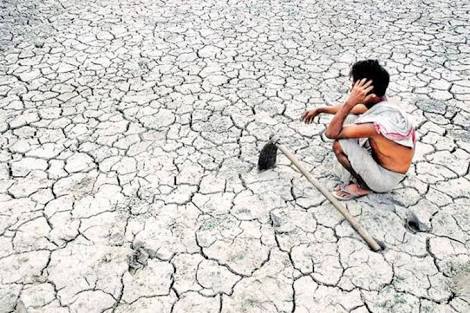
Several regions of acute water-scarcity have emerged in India and during summer these expend to a much wider area. Droughts are also becoming more frequent and this has added to water scarcity, sometimes for very prolonged periods. While the creation of new sanitation facilities in villages is less than what is often claimed, still to the extent that these have been created these cannot be used in conditions of acute water scarcity. It is clear and firmly established principle that drinking water, sanitation and domestic use should get the topmost priority in areas which are affected by extreme water scarcity. However this appears to be far from the actual practice in several water-scarce areas in India.
On the contrary it is common to see that often it is the considerations of commercial gain that often call the shots . One example of this is that in several water scarce areas of Rajasthan mining activity has been allowed indiscriminately. In Himalayan region indiscriminate construction work in such areas has sometimes led to deposition of huge rubble on water springs, effectively ruining them.
In other places water intensive industries have been set up and in some places water intensive crops have expanded, sometimes both aspects linked to each other. While reporting on water scarce areas of Bundelkhand and villages struggling hard to cope with drinking water shortage for villagers and farm animals, I came across certain patches which were growing a highly water-intensive crop mentha. This meant that those who had the resources could use the scarce water resources in a highly bountiful way. If this is possible for some of the better resourced farmers, then it is certainly possible on a much larger scale for industries.
Several parts of Maharashtra have often attracted criticism for ignoring the needs of small subsistence peasants while allowing water to be used predominantly for sugarcane farmers who constitute a powerful lobby. Sugarcane is a highly water-intensive crop. Subsistence farmers generally grow millets or coarse cereals which require little water and are more suitable for water-scarcity conditions.
A report in India Today (October 15, 2018) by Kiran D. Tare from Marathwada region (Maharashtra) said that this region is facing yet another water crisis and it’s again a result of woeful mismanagement of available water resources. The reservoirs at Jayakwadi, Manjra and Majalgaon — the three dams that supply water to the region — had almost no water. On September 30, 2018 Jayakwadi was at a fourth of its capacity, while the others had run dry. It was a scary situation given that nearly two million people depended on the water in these dams. Across the region consisting of eight districts, all available water bodies together in September-October 2018 had just 31.2 per cent water stock while around the same time in 2017, it stood at 82.2 per cent.
What is the real cause of this water scarcity. This report points out – indiscriminate release of water for sugarcane cultivation and alcohol production has depleted the reservoirs. “There are some 200 distilleries in Aurangabad, which use enormous quantities of potable water. In Latur, where river channels were widened last year to improve inflows to the dams, indiscriminate release of water to cane farms has exhausted the precious reserves.”
This report concludes by saying, “Despite the scarcity, six sugar mills are still functioning in drought-prone Latur. Municipal commissioner Kaustubh Diwegaonkar has announced that the ‘live stock’ of water in Manjra is over. The remaining ‘dead stock’ can be stretched for a year, but only if water is not supplied at regular intervals.”
Such reports have appeared time to time from several water scares areas of the country. Distilleries consume a lot of water and in addition also cause a lot of water pollution . Yet these are coming up in water-scarce areas. Hotels with big swimming pools continue to come up in water-scarce areas where people are experiencing extreme drinking water shortage. In several tribal areas known for conditions of water scarcity of villages and hamlets, dams are being built with the stated or unstated purposes of diverting water to big mining and industrial projects.
We really need to take a close look at water use priorities and realities of various regions to get a clear understanding of the extent to which the actual water use (existing and planned) is departing from the priorities that are needed. A basic need like water cannot be denied to people and farm animals by diverting it to non-priority uses. Water audits and careful water planning are needed for this. Experts can contribute much to this, but effective decisions will emerge only if there is political support for this and if mobilization of people can ensure this.
Bharat Dogra is a journalist and author. His recent books include Planet in Peril and Man over Machine.
GET COUNTERCURRENTS DAILY NEWSLETTER STRAIGHT TO YOUR INBOX













































